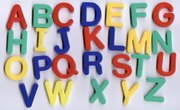Most children start learning how to write at the same time they learn how to read, which is usually in kindergarten. Some children may begin limited reading and writing instruction in preschool. Creating worksheets with word tracing can help students strengthen their writing skills while also becoming more familiar with certain words and phonetic rules. You can save a lot of money by making these worksheets instead of buying them, and you can customize them based on your students' reading level.
Include Sight Words
Sight words are those that appear often in the texts we read and write, but they don't always follow the traditional rules of phonics, so they aren't easy to sound out. Examples include "the," "like," "have" and "are." Children learn to read these words by recognizing them by sight. Children learn sight words through memorization. Including sight words in your handwriting tracing worksheets reinforces a student's connection between the physical movement of their hand and the memory of the word.
Create Phonological Awareness
Children begin building literacy long before they learn how to read or write. One way they do this is to develop phonological awareness, or an understanding of the sounds that make up the words. You can help create phonological awareness for students by exposing them to rhyming words, alliteration (repeating consonant sounds) and assonance (repeating vowel sounds). Create worksheets around these groupings of words, and talk to students about these literary devices before they begin their writing. Again, when they begin tracing the words, they will create a stronger connection to the words in their minds.
Use Themes
Creating themed worksheets can help children make connections between words and build their vocabulary through their writing exercises. For example, you might create a worksheet with a group of action verbs. You might even make the worksheet more specific by creating a group of action verbs related to cooking or exercising. Other themed worksheets might include holiday words, adjectives or prepositions. All words should be selected for the grade level or reading level of the class. When children trace the words, they commit them to memory and strengthen their handwriting skills.
Create the Words
Instead of buying or downloading word tracing worksheets, you can create them yourself in a word processor. Instead of typing out the words with a normal font, choose a font that has dotted or dashed letters. You may find this option under fonts or under special characters, depending on your word processing program. If you can't do that, print the words in a lighter color. Decide between print or cursive, and choose a large font. Ideally, the words should fill a three-lined row on paper designed for handwriting practice. Print the model word in solid font on the left, and print the word to trace in the dotted or lighter font on the right. Students can look at the model and practice on the right.
Related Articles
References
Writer Bio
Maria Magher has been working as a professional writer since 2001. She has worked as an ESL teacher, a freshman composition teacher and an education reporter, writing for regional newspapers and online publications. She has written about parenting for Pampers and other websites. She has a Master's degree in English and creative writing.











